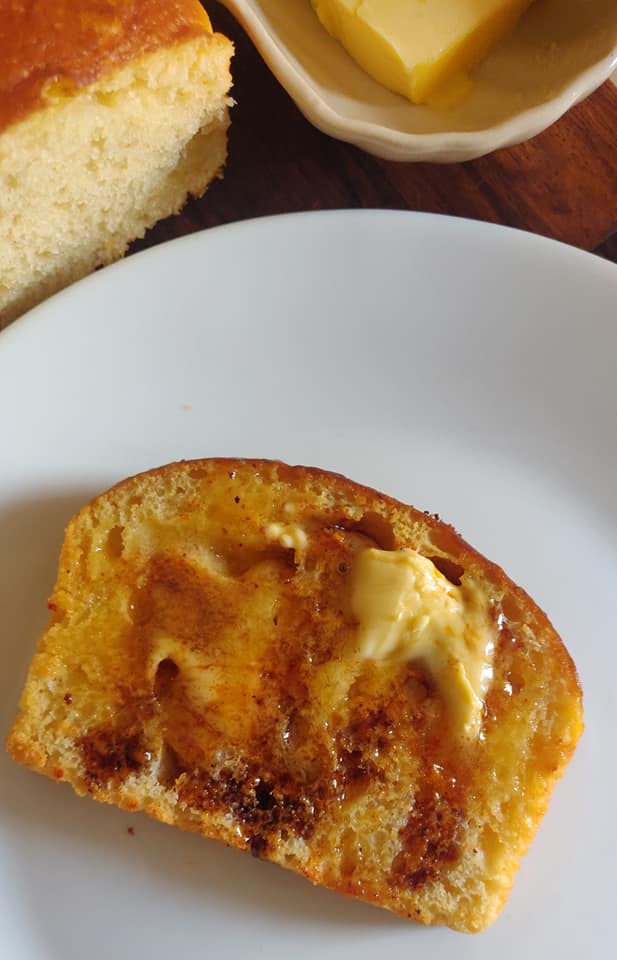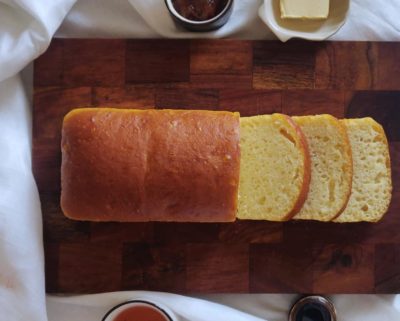Shokupan or Japanese Milk Bread Recipe

I see a lot of people who have become interested in bread making during this lockdown! One reason being our limited mobility to step out, familiarity of bread on our breakfast tables and the finally having the time that most people associate with bread making. Well, it does need time but most of it doesn’t need one to engage with the dough, rather needs one to leave it alone. Whatever the reasons, anytime is a good time to start baking a loaf or two. It is a satisfying, calming process.
The most common problem that I hear from people, including Om about home baked bread, is that it turns crusty and dense after it has sat for a day and half. Which makes it great to have with stews and soups but makes it difficult more many to have as a toast. A great alternative to that is to use the Yudane method or the Tangzhong, as the Chinese call it.
The Yudane method originated in Japan and it became widespread and popular in Southeast Asia to bake bread when a Chinese food writer Yvonne Chen introduced “Tangzhong” roux as a secret ingredient to bake the super soft and light Japanese bread in her book called “Bread Doctor”. Tangzhong roux is made by 1:5 ratio of bakers or bread flour to water. The mixture is heated up to 65-degrees celsius then cooled down to room temperature and added to the bread dough, ideally in a 35% ratio of the total flour for the dough.
The resulting dough retains much greater percentage of moisture than other methods, making the breads soft and fluffy. The bread almost has a mochi like texture, better crust colour and retains the texture much longer. I use the method also to make a black sesame bread, and whole wheat flour breads. The whole wheat makes it denser than white flour, but is still.softwr than regular whole wheat bread.
The Shokupan, is traditionally made with bread flour, and is a rich bread with milk, sugar, butter and egg in the dough. The pillowy bread is typically had as thick slices of toast for breakfast or goes into making the popular Japanese egg sandwiches.

Shokupan
Water Roux or Yudane
25 g bread flour, 100 ml water
Bread Dough
125 ml whole milk, lukewarm, 2 1/4 teaspoons active dry yeast, 450 g bread flour plus extra for dusting, 60 g sugar, 1 teaspoon salt, 1 medium egg, plus another for egg wash, 30 g unsalted butter, room temperature
For the roux
1. Whisk flour and water together in a small saucepan. Place over medium-low heat on the stove.
2. Cook, whisking constantly, until the mixture thickens into a pudding-like consistency and you can draw lines in the mixture with a spatula.
3. Let the Yudane cool to room temperature.. You can also store in the refrigerator for a couple days and bring to room temperature before using.
For the Bread
1. Combine yeast and milk (not above 100° C or it will kill the yeast) and 2 teaspoons of the sugar in a bowl and let stand for about 5-7 minutes until yeast blooms.
2. Combine the flour, the rest of the sugar, and salt in the bowl large enough to hold the dough. Add the yeast mixture, yudane, and egg.
3. Mix all the ingredients by hand or with a dough hook attachment of a mixer until it comes together into a soft, sticky dough. It takes about 7-10 minutes.
4. If kneading the dough by hand, tip the dough onto a clean floured surface, stretch the dough a bit, add the butter in the middle, fold over and knead to incorporate. If using an electric mixer, just tip the butter in.
5. Continue beating the dough for about 10-15 minutes until the dough is smooth and elastic. The process takes longer if your are kneading by hand.
6. At this point, the dough should stretch out fairly thin without breaking. If it breaks right away when you try to stretch, mix it for a couple more minutes.
7. Turn out the dough into an oiled bowl and cover with plastic wrap. Let proof for about 40 minutes or until dough has doubled in size.
8. When the dough has doubled in size and is puffy and springy to the touch, take the dough out on a floured surface and split into 4 equal pieces. The dough is not airy and spider web-like as it is with normal yeast doughs. So do not punch it down.
9. Roll each piece into a ball. Cover with plastic wrap and let rest for 15 minutes.
10. Grease a 5″x9″ loaf pan. Set aside.
11. Roll each piece out on a lightly floured surface into a long oval. Fold the right third of the oval along the long edge over the middle, then fold the left third of the oval over the middle to make a long, narrow envelope. Lightly roll over the seam to flatten and seal. Roll each envelope along the short ends to make a fat roll.
12. Arrange the four rolls of dough, seam side down, in the prepared loaf pan. Cover with plastic wrap. Let proof for another 40 minutes until the dough reaches just below the rim of the loaf pan.
13. Preheat oven to 350 degrees F while the bread is proofing for the second time.
14. Brush the top of the dough with a little egg wash. Place in the oven and bake for about 30-35 minutes, until the top is dark golden brown and the bread is firm to the touch and sounds hollow when you tap it.
15. Turn out bread onto wire rack and let cool before eating.
Notes:
I use a recipe from dessertfirstgirl.com
but I have tweaked it over time to suit my kitchen conditions and higher temperatures that o operate in.The original recipes call for super white, bread flour which I didn’t have access to. This loaf was made with regular all purpose flour, which altered the colour (it was a bit creamish rather than the super white bread). The lift was less than the bread flour and the texture, tad less pillowy but the taste was absolutely fine.
One can substitute white all purpose flour with whole wheat but then it will not technically be a Shokupan.

